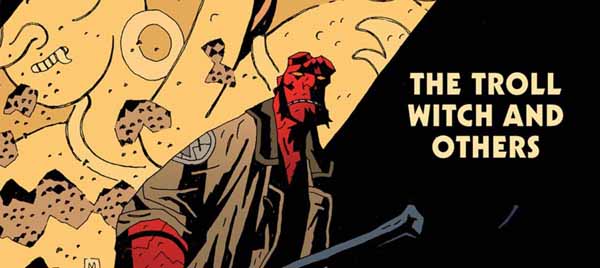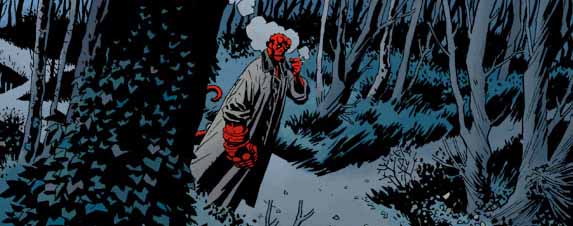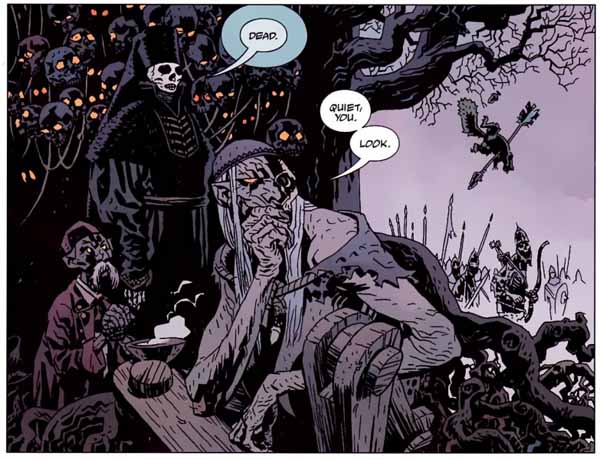
The Great Hellboy Re-Reading Project Part VIII: Darkness Calls
I have recently begun an epic project: re-reading Mike Mignola’s complete Hellboy saga from the very beginning! What began as a series of sporadic mini-series and short-stories featuring the big red occult investigator has deepened over the past twenty years into what is, for my money, the richest and most consistently entertaining comic book universe of stories out there. Click here for part one, in which I discussed the very first Hellboy tale: the four-part mini-series Seed of Destruction. Click here for part two, in which I discussed The Wolves of Saint August, The Corpse and the Iron Shoes, and Wake the Devil. Click here for part three, in which I discussed a variety of Hellboy short stories including The Right Hand of Doom and Box Full of Evil. Click here for part four, in which I discussed Hellboy’s last mission for the B.P.R.D.: Conquerer Worm. Click here for part five, in which I discussed the beginning of a series of B.P.R.D. spin-offs and a whole new expansion of the Hellboy universe: Plague of Frogs. Click here for part six, in which I discuss the major shift in the Hellboy story that took-place in The Third Wish and The Island. Click here for part seven, in which I discuss on the incredible B.P.R.D. mini-series that became the new central focus of the continuing Hellboy saga.
The Troll Witch and Others (2007) — The seventh Hellboy trade paperback collection, called The Troll Witch and Others, collects Makoma (which I reviewed in part 7 of my re-read) along with several other great short stories, all of which I had missed when they were originally published. (Most of them appeared in Dark Horse’s various Book Of… short story collections.) The Penanggalan has a spooky supernatural villain with an awesome name. The Hydra and the Lion, which tells the story of a creature who might be the real Hercules, has what is possibly the single greatest line I have ever read in a comic book: “You think the little girl was the ghost of his pants?” The Troll Witch is a very sweet, very sad story, my favorite of the collection. It’s unusual in that Hellboy doesn’t fight anyone and winds up letting the creature he encounters live. The Vampire of Prague is illustrated by comics master P. Craig Russell but it doesn’t work for me. I wasn’t that interested in the story and felt Mr. Russell’s artwork was too light and bubbly for Hellboy. (Though the story is notable in that it will be referred back to several years down the line in Hellboy in Hell.) Dr. Karp’s Experiment is my second favorite story in the collection, an amazingly wacky story in which Hellboy travels back in time (very briefly). It’s fun to see Hellboy in a time-travel story, a sci-fi trope not usually used by Mr. Mignola. The Ghoul is a weird one, a story I’ve read several times but still don’t feel I quite understand. I do love the puppet production of Hamlet, something that is so bizarre and so uniquely Mignola. Dr. Karp’s Experiment and The Ghoul both feature a pretty female B.P.R.D. agent (named in The Ghoul as Pauline Raskin). Does she ever appear in any more future Hellboy tales? I don’t think she does, which is a shame, she seems like an interesting new character here in these stories. I’ll be looking out for her as this re-read project continues.
B.P.R.D.: Killing Ground (2007) — Continuing right on the heels of B.P.R.D.: Garden of Souls, Killing Ground is another amazing B.P.R.D. mini-series. At this point, these B.P.R.D. series were firmly entrenched as the “main” story-line of the Hellboy universe. Things take a dark, violent turn in this one, a horror/suspense tale in which some very bad stuff goes down in the B.P.R.D. headquarters over the course of a few snowy days.
Issue #1 sets the stage, a tense start to this gritty tale. It’s tragic to re-read it, knowing what’s coming. All of the agents are so absorbed in their own problems that they’re totally unprepared to face the trouble that is about to descend upon them. (Guy Davis draws a gorgeous image on the second-to-last page — of the H.Q. in terrible, windy weather — that really turns the screws on the audience. Our heroes are not going to be able to get any help from the outside.)
My last few posts have focused on the awesome back-story of Captain Daimio and his connection to the Crimson Lotus. In issue #1, Daimio — when confronted by Johann about his connection to that WWII villain — claims that his grandmother didn’t have super-powers, she was just an ordinary woman. Based on what we will see of her years later in Lobster Johnson: A Scent of Lotus, I am not sure Ben Daimio was correct!
Things turn ugly in issue #2, with the unfortunate death of the mysterious “Chinaman” who’d been doing something with Daimio. At the time I was stunned that he was killed off without our ever getting to know his story, but luckily that secret will finally be revealed in issue #5.
I love the whole story of Johann in his new huge body, and how he is seduced by the pleasures of the flesh that he’d thought were long-since lost to him. He acts like a jerk to his friends, but it’s still heartbreaking when the Daimio/jaguar-monster rips his throat out in issue #4. (I also love how when we see Johann’s spirit in issue #5, he’s in the form of that huge body. Only at the end of the issue has his spirit returned to Johann’s normal form of a skinny, goateed German gentleman.)
Holy cow, it still astonishes me when Lobster Johnson’s spirit emerges from Johann’s body and shoots Liz (actually the spirit of Memnan Saa that is within her). I love that the intriguing character of the Lobster is still somehow involved in these stories. I could tell that Wake the Devil had just scratched the surface of this character. (The Lobster’s actions were mystifying to me when I originally read this issue, but of course very soon we’ll get Lobster Johnson: The Iron Prometheus, which will show us just why the Lobster hates Memnan Saa…)
Of course, the most important story-element in Killing Ground is the tragic fate of Captain Daimio, who is unable to keep the curse inside him and transforms fully into the Jaguar god, wreaking havoc. This isn’t actually the last we’ll see of Daimio, but it will be quite a while before we seen him again. I love the enigmatic ending of Daimio and the Wendigo facing off in the woods. Why DID Daimio free the Wendigo? Was Daimio in control when he did that — was he somehow trying to help Darryl? Or was the jaguar in control then, just wreaking havoc? Or was there some other purpose to his actions?
Hellboy: Darkness Calls (2007) — For the first time in years, Hellboy steps back into the center stage, as we get our first real Hellboy epic since 2001’s Conquerer Worm. Duncan Fegredo comes aboard as the new Hellboy artist, and he’ll illustrate this entire four-part Hellboy saga (the mini-series Darkness Calls, The Wild Hunt, The Storm, and The Fury). Obviously in an ideal world Mike Mignola would illustrate every single Hellboy story or, failing that, at least the major ones. But I have long-since accepted that this is not to be, and I have come to adore the expansion of the Hellboy world that happened once Mr. Mignola began working with a small team of collaborators. I wouldn’t want to give that up. Mr. Fegredo is a phenomenal artist and he does astonishingly great work here. His work has the weight that is necessary for Hellboy and that feels evocative of Mr. Mignola’s work. (Mr. Fegredo is not afraid of solid blacks in his artwork!) But Mr. Fegredo isn’t just a Mignola imitator, he has a distinct style of his own. The wealth of detail he is able to put in every one of his panels is staggering. There is imagery in Darkness Calls that rivals the best of Mr. Mignola’s stuff.
The series opens by pulling together lots of old story-threads. Igor Bromhead (from Box Full of Evil) returns, and summons Hecate (last seen in The Island, telling Hellboy that they’d be together on the last day of the world). It turns out the skeleton of Vladimir Giurescu (last seen getting destroyed by Hellboy back in Wake the Devil) was found by Bromhead, and Giurescu told Bromhead the name of the human, Ilsa Haupstein, who was now part of her (once they merged in the Iron Maiden in Wake the Devil), thus giving Bromhead power over Hecate. (Holy cow, I am hugely creeped out by the scene in issue #2 of Ilsa’s corpse being embraced by Giurescu’s skeleton as Bromhead walls them up for eternity. Euch!!)
Meanwhile, witches have found Hellboy’s discarded horns (also from Wake the Devil) and used them to fashion a sort of Hellboy voodoo-scultpure. Hellboy has finally returned from his years-long sojourn in the ocean, washing up in England. The witches use their voodoo-scultpure to summon Hellboy and try to make him their king, but he refuses. The witches then turn to the Baba Yaga, who seeks revenge on Hellboy for his shooting out her eye (an event referenced in Wake the Devil which we saw in the early Hellboy short story The Baba Yaga). The Baba Yaga transports Hellboy into her realm, the “thrice-nine lands in the thrice-tenth kingdom,” where she pits her servant Koschei the Deathless against Hellboy.
While all this is going on, an even greater threat is brewing, one that also involves a number of wonderfully intriguing old story-threads. The Gruagach (who was trapped inside the body of the pig-creature Grom all the way back in one of the earliest Hellboy short stories, The Corpse, and who then popped up in The Third Wish, raging against the Faerie King Dagda for allowing their time ruling the world to have passed) returns, plotting to unleash something very bad (we won’t find out just what until The Wild Hunt).
There is so much great stuff in this mini-series to chew on. It’s great seeing all of these major and minor characters again, and I love how they all seem to be involved in the beginning of this epic story. In issue #2, we see the Baba Yaga’s servant Koku again (he’s the one who gave Rasputin the Iron Maiden back in Wake the Devil). In that same issue, we also get an intriguing description, from the witches, of Hellboy’s dad: “Lord over the witches of Lancashire and Abbotsbury. (The witches also, FINALLY, clarify the ending of Wake the Devil, explaining that a bit of Hecate’s spirit was in Giurescu, but then she abandoned him to merge with Ilsa in the Iron Maiden.)
In issue #3 we see the Baba Yaga assassinate an apparently once-powerful god named Perun, described as “God of storms. Lord over the whole world.” Had we seen Perun before? I’m not clear on who exactly he was or what was the significance of his assassination.
In issue #4, we get the very memorable meeting of Hellboy and the ghost of the little girl and her doll, who helps Hellboy before being killed by Koschei. She gives her name as Vasilisa, and I have always wondered if she’s connected to the demon in the form of a young Russian girl named Varvara who Professor Buttenholm meets in B.P.R.D. 1946.
In issue #5, we return to the group who we have seen observing Hellboy since the very beginning. But now we seem to have two groups. On one side is the Baba Yaga, Koku, and a skeletal figure (is she supposed to represent Death?). They seem to clearly be the villains. While on the other side is the Faerie King and the bald, smoking goblin. They seem to be on Hellboy’s side but also seem surprisingly powerless, unwilling or unable to intervene. The Faerie King predicts that they will not survive what is coming.
In issue #6, the skeletal figure drops a huge bombshell on the Baba Yaga and the audience. She says: “Now, finally, you understand. Hellboy is as deathless as Koschei.” Now we know just how/why Hellboy has survived so many grievous injuries!!!
The Faerie King finally gets a name — Dagda — right before Gruagach kills him. It’s interesting to me that Dagda isn’t able to mount much of a counter-argument to Gruagach. Why SHOULD they all just go quietly into darkness? Gruagach’s desire to once again be a power in the world is tragically understandable. And I am left wondering just why Dagda has seemed to have looked so favorably on Hellboy all this time, even as Hellboy has spent so much of his life killing Dagda’s kin.
As with Conquerer Worm, I’d heard that Darkness Calls was given an important epilogue in the trade paperback. For this re-read project, I finally tracked that down and was once again bowled over by the critical information imparted in the epilogue. There are actually TWO epilogues. The first, illustrated by Duncan Fegredo, casts the opening of the mini-series in an entirely new light. The second, illustrated by Mike Mignola himself (!), is even more of a doozy, as the masked Sir Edward Grey converses with Hecate, and she lays on him (and us) some hugely important information. First, she confirms that she and the woman/goddess who seduced king Thoth and helped cause the downfall of Hyperborea are one and the same. Furthermore, the Black Goddess image we have been seeing throughout Hellboy universe stories for a while now is also confirmed as being a depiction of Hecate. Hecate also repeats her prediction that she and Hellboy will meet again on “the last day,” and that soon Sir Edward will aid Hellboy, but that act will lead to his (Sir Edward’s) undoing. “Before you are finally allowed to die, you will suffer as few men have ever suffered.” Wow!
Even before that epilogue, Darkness Calls ends on a huge cliffhanger. It’s great to see such an awesome Hellboy adventure again, so jam-packed with action and revelations. Lots more is coming, but before The Wild Hunt arrives we get a series of other mini-series. Each seems to be focusing on a minor character from the Hellboy universe, but each becomes a wonderfully important expansion of the universe.
I’ll dive into Lobster Johnson: The Iron Prometheus, B.P.R.D. 1946, and Abe Sapien: The Drowning next time!
The issues discussed in this post were collected in: Hellboy vol.7 The Troll Witch and Others, B.P.R.D. Plague of Frogs vol.3 and Hellboy vol. 8 Darkness Calls.



